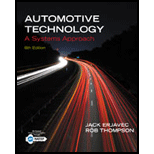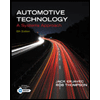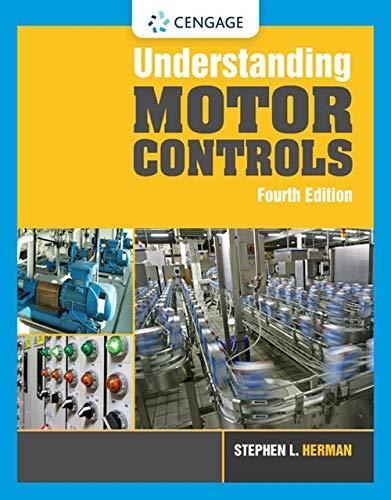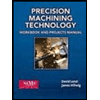
Automotive Technology: A Systems Approach (MindTap Course List)
6th Edition
ISBN: 9781133612315
Author: Jack Erjavec, Rob Thompson
Publisher: Cengage Learning
expand_more
expand_more
format_list_bulleted
Concept explainers
Textbook Question
Chapter 38, Problem 15RQ
What does a shift blocking system do, and how does it basically work?
Expert Solution & Answer
Trending nowThis is a popular solution!

Students have asked these similar questions
What is the difference between a pilotduty and a line break overload?
A major disadvantage of on/off control is that it cannot work for applications requiring very small changes from the set point (sp)
a. true
b. false
How is a vertically coded control unit constructed, and what components does it need?
Chapter 38 Solutions
Automotive Technology: A Systems Approach (MindTap Course List)
Ch. 38 - What determines whether a conventional...Ch. 38 - Name the three drive configurations that a gearset...Ch. 38 - True or False? A reverse idler gear changes the...Ch. 38 - Define the purpose of the final drive gears.Ch. 38 - Explain the role of shift rails and shift forks in...Ch. 38 - True or False? In most transmissions and...Ch. 38 - The number of gear teeth per unit of measurement...Ch. 38 - Which of the following gear ratios indicates an...Ch. 38 - Which type of gear develops gear whine at high...Ch. 38 - When an idler gear is placed between the driving...
Ch. 38 - The component used to ensure that the mainshaft...Ch. 38 - In a transaxle, the pinion gear on the pinion...Ch. 38 - True or False? The cone on a synchronizers...Ch. 38 - Which of the following gear ratios provides the...Ch. 38 - What does a shift blocking system do, and how does...Ch. 38 - Technician A says that most transaxles have a...Ch. 38 - While discussing the various types of...Ch. 38 - Technician A says that the countergear or cluster...Ch. 38 - Technician A says that reverse lamp switches are...Ch. 38 - Technician A says that if a single idler gear is...Ch. 38 - Technician A says that in a conventional...Ch. 38 - While discussing the power flow through a...Ch. 38 - Prob. 8ASRQCh. 38 - Prob. 9ASRQCh. 38 - While discussing shift mechanisms: Technician A...
Knowledge Booster
Learn more about
Need a deep-dive on the concept behind this application? Look no further. Learn more about this topic, mechanical-engineering and related others by exploring similar questions and additional content below.Similar questions
- How do the different controllers help in operation?arrow_forwardWhich of the following is a basic function of a computer? To store information To process information To send out commands All of the abovearrow_forwardHow is a vertically coded control unit constructed, and what components does it require?arrow_forward
- Hello Sir.Good Evening. I'm currently taking an exam Control System Lesso I have a question related Control System Lesson. The following below is my question.Please advise fast, Thank you so much.arrow_forwardIn what ways do controllers for various devices aid in operation?arrow_forward(a) The feeder-selector device at one of the workstations of an assembly machine has a feed rate of 56 components/min and provides a throughput of one part in five. The ideal cycle time of the assembly machine is 6 sec. The low-level sensor on the feed track is set at 10 components, and the high-level sensor is set at 25 components. (a) How long will it take for the supply of components to be depleted from the high-level sensor to the low-level sensor once the feeder-selector device is turned off? (b) How long will it take for the components to be resupplied from the low-level sensor to the high-level sensor, on average, after the feeder-selector device is turned on? (c) What are the time proportions that the feeder-selector device is turned on and turned off?arrow_forward
arrow_back_ios
SEE MORE QUESTIONS
arrow_forward_ios
Recommended textbooks for you
 Automotive Technology: A Systems Approach (MindTa...Mechanical EngineeringISBN:9781133612315Author:Jack Erjavec, Rob ThompsonPublisher:Cengage Learning
Automotive Technology: A Systems Approach (MindTa...Mechanical EngineeringISBN:9781133612315Author:Jack Erjavec, Rob ThompsonPublisher:Cengage Learning Understanding Motor ControlsMechanical EngineeringISBN:9781337798686Author:Stephen L. HermanPublisher:Delmar Cengage Learning
Understanding Motor ControlsMechanical EngineeringISBN:9781337798686Author:Stephen L. HermanPublisher:Delmar Cengage Learning Precision Machining Technology (MindTap Course Li...Mechanical EngineeringISBN:9781285444543Author:Peter J. Hoffman, Eric S. Hopewell, Brian JanesPublisher:Cengage Learning
Precision Machining Technology (MindTap Course Li...Mechanical EngineeringISBN:9781285444543Author:Peter J. Hoffman, Eric S. Hopewell, Brian JanesPublisher:Cengage Learning Refrigeration and Air Conditioning Technology (Mi...Mechanical EngineeringISBN:9781305578296Author:John Tomczyk, Eugene Silberstein, Bill Whitman, Bill JohnsonPublisher:Cengage Learning
Refrigeration and Air Conditioning Technology (Mi...Mechanical EngineeringISBN:9781305578296Author:John Tomczyk, Eugene Silberstein, Bill Whitman, Bill JohnsonPublisher:Cengage Learning

Automotive Technology: A Systems Approach (MindTa...
Mechanical Engineering
ISBN:9781133612315
Author:Jack Erjavec, Rob Thompson
Publisher:Cengage Learning

Understanding Motor Controls
Mechanical Engineering
ISBN:9781337798686
Author:Stephen L. Herman
Publisher:Delmar Cengage Learning

Precision Machining Technology (MindTap Course Li...
Mechanical Engineering
ISBN:9781285444543
Author:Peter J. Hoffman, Eric S. Hopewell, Brian Janes
Publisher:Cengage Learning

Refrigeration and Air Conditioning Technology (Mi...
Mechanical Engineering
ISBN:9781305578296
Author:John Tomczyk, Eugene Silberstein, Bill Whitman, Bill Johnson
Publisher:Cengage Learning
Types Of loads - Engineering Mechanics | Abhishek Explained; Author: Prime Course;https://www.youtube.com/watch?v=4JVoL9wb5yM;License: Standard YouTube License, CC-BY